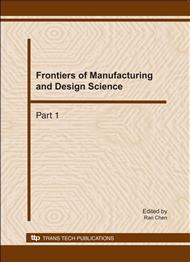p.2902
p.2907
p.2912
p.2918
p.2922
p.2926
p.2931
p.2935
p.2940
The Effect of Splicing Shape and Interval Length on the Failure Mode of Laminated Composites under Tensile Condition
Abstract:
This paper presents an experimental investigation on the failure modes of glass fiber reinforced 2D woven fabric with ladder splicing laminate composites. On the basis of [0/0/+45/90/-45/90]s ply sequence, six kinds of laminated performs with different splicing interval lengths which were 4mm, 8mm, 12mm respectively and two different splicing shape which were ladder splicing and double vertical line splicing, and a kind of laminated perform with continuous laminates of 2D glass fiber woven fabric were made. By means of RTM molding technology, the technological parameters of RTM processing were designed as follows: injection temperature was 25°C, injection duration time was 180min and injection pressure was 0.4MPa, the epoxy resin based 2D glass fiber woven fabric RTM laminated specimen were prepared. According to the GB/T 1447-2005 and GB/T 1449-2005standard test method, the failure modes of 2D glass fiber woven fabric laminated RTM specimen were tested. Results show that the failure modes of laminate composites manifest as rapid damage in the form of line inlay mode and wedge shape mode at 4mm interval length condition, and accumulating failure in the form of inlay layer slippage - fiber pulled out mode and fiber fracture - splicing layer deboning mode at 12mm interval length. Otherwise, all fracture position of splicing laminates occurs at the site of splicing line because of the concentration of tensile stress.
Info:
Periodical:
Pages:
2922-2925
Citation:
Online since:
December 2010
Authors:
Keywords:
Price:
Сopyright:
© 2011 Trans Tech Publications Ltd. All Rights Reserved
Share:
Citation:


